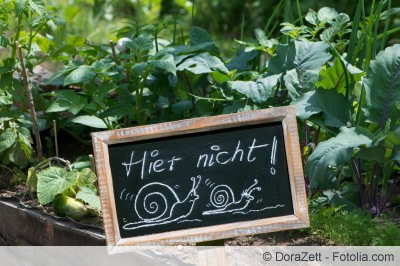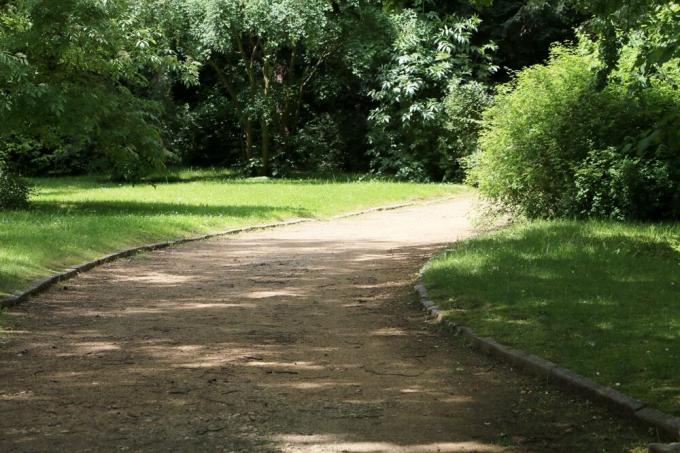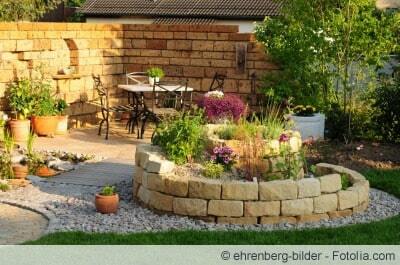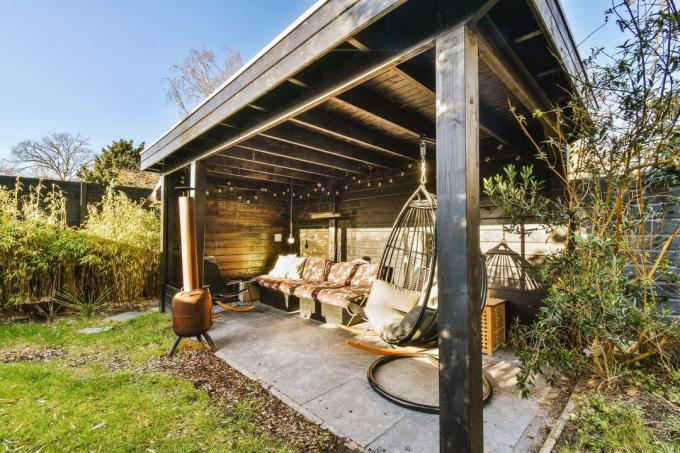

Table of contents
- materials
- Different variations
- rollboarder
- Mini palisades with lace
- Palisades as bed borders
- Structure without concrete foundation
- Bed borders with foundation
- Step 1: Dig a trench
- Step 2: Concrete in the wood
- Step 3: Cure and fill
- Conclusion
With a little skill and creativity, an attractive wooden bed border can be designed to be visually appealing. However, wood is a material that begins to deteriorate after only a short time in moist soil. If you opt for a bed edging made of wood, you should make sure that Correspondingly weather-resistant wood or wood specially impregnated with protective agents is used becomes. The means of protection that are used should be free of harmful substances and environmentally friendly.
materials
A good bed border not only looks beautiful, it also prevents the lawn, weeds or even the plants themselves from spreading unhindered. Wooden bed edgings look very natural and fit into almost any garden, whether it's a cottage garden or a modern facility. The border made of wood does not necessarily have to follow a straight line, it also looks appealing round or curved lines, well built with pegs set vertically in the ground can. Depending on which type of wood is used, it is necessary to protect it from the effects of the weather – especially moisture.
- Weather-resistant types of wood: Douglas fir, robinia, oak, larch
- pressure-treated wood: spruce (very light and relatively cheap)
- Paint untreated wood yourself with glaze or paint
Different variations
Depending on your taste and the circumstances in your own garden, a wide variety of design options can be used for a bed border made of wood. Thick wooden trunks or branches, for example, which can simply be placed on the bed as a border, look very natural. Other bed borders consist of thick pieces of wood with a round or rectangular cross-section, which are usually struck vertically into the ground or embedded in concrete.
- palisades (logs)
- Wooden boards, low fences
- Rollboarder (rollboard, roll palisade, lawn edge)
- round logs
rollboarder
Rollboarders are called bed borders or lawn edges, where the individual (wooden) elements are connected with wire. This makes setting very easy and curves are also possible. Rollboarders made of wood are usually 30 centimeters high and about 190 centimeters long. If shorter pieces are required, the wire can simply be severed with pliers.
- Step 1: Mark the course – The later course of the bed edging is marked with a guide line or fine sand.
- Step 1: Dig a ditch - Use a spade to dig a ditch about 20 centimeters deep. The ditch does not have to be very wide, a slightly wider slit will do.
- Step: Adjust and insert the rollboard - The rollboard must first be cut to the right width by cutting the wires with pliers. Then you insert it into the punched slot. To ensure good stability, the Rollboard should be sunk into the ground up to about the second wire border. If necessary, hammer in a little more with a rubber mallet to align the upper edge evenly (spirit level). Tip: If you don't have a rubber mallet, you should put a wooden board on top so that the surface of the wood isn't damaged by the metal head of the hammer.
- Step: Filling - First fill the slot with fine gravel and distribute the excavated soil on the gravel. Step down well.
Mini palisades with lace

So-called mini palisades are also suitable for optically separating beds or as lawn edges. Palisades with a pointed end are recommended for quick and uncomplicated insertion. To build a bed border from mini palisades yourself, all you need is the palisades, a spade, a rubber mallet and a guide. As an alternative to a rubber mallet, a normal hammer can also be used if a wooden board is placed underneath when striking.
- Step: Set History – The course of the bed border is best determined with a stretched cord. To ensure that the palisades later form an exact alignment, a narrow channel should be dug with a spade.
- Step: Drive in the palisades – The palisades must now be precisely aligned. For example, a bar can be nailed to two or three round timbers. The palisades are driven into the ground to the desired depth with a hammer.
Palisades as bed borders
With the help of round timber, so-called palisades, you can build a bed border yourself. If you use palisades of different heights, you can achieve a very individual design. In addition, palisades can also be used for beds on slopes or stepped gardens.
Materials needed
- Palisades/logs (available in various lengths and diameters)
- note that about a third of the wood is buried in the ground
- gravel or grit
- nails
needed tools
- spade (possibly shovel)
- wall cord and wooden sticks
- ruler
- level
- Rubber mallet (alternatively hammer and wooden board)
Structure without concrete foundation
On level ground, a palisade acts like a fence that encloses the bed and divides the garden into areas. If the ground offers sufficient stability and the palisades are not very high, you can work without a concrete foundation.
- Step 1: Dig a ditch - First of all, the later course of the border of the bed should be marked all around using the sticks and the guide line. A ditch is dug along the line, the depth of which corresponds to about a third of the length of the palisade. There are also 20 centimeters for drainage.
- Step: Create drainage - A thick layer of gravel or grit is filled into the ditch (about 20 cm). This ensures that water can drain off and the wood does not rot.
- Step: Set up the palisades - the logs are now placed next to each other in the trench and aligned in height and alignment using the guide line. So that relatively long palisades do not shift, they should be fixed with a nailed straightedge (towards the inside of the bed).
- Step: Fixing - If short logs have been used, the trench can simply be filled with chippings and garden soil. The soil is compacted by gently stepping on it so that it does not later become undermined. Before it is completely filled up, the straightedge must of course be carefully removed.
Bed borders with foundation
If the terrain varies in height, very sandy soil or high palisades, the logs should definitely be cast in concrete. In addition, a barrier with roofing felt or foil is necessary on the raised side so that the moisture is kept away from the wood and the soil does not trickle through.
Additional Materials
- Garden concrete (concrete, sand, water)
- foil or roofing felt
Additional tools
- Bucket, bucket or wheelbarrow for mixing the concrete
- mortar trowel
Step 1: Dig a trench
After the course has been determined by a guideline, a ditch must now be dug that corresponds in depth to about a third of the length of the palisade, plus an additional 20 centimeters.
Step 2: Concrete in the wood
There are two different options when concreting the wood:
- Longer palisades can be stabilized laterally with concrete. First, a 20 cm thick layer of gravel is poured in for drainage and the logs are inserted and aligned. For stabilization, place a trowel of concrete in front of and behind the palisade and flatten it out at the sides.
- Only fill in a thin drainage layer of gravel (5 cm). Then fill in garden concrete to a height of about 10 cm and insert and align the wood (not all the way to the bottom). When all the timbers are in the concrete, another layer of concrete is refilled from the right and left (about 10 cm). To do this, alternately fill a trowel in front of and behind the logs so that they are not displaced when filling from one side. This variant is recommended for steep slopes.
Step 3: Cure and fill
The concrete must now harden over several days (a week is better). Then it can be filled with a layer of gravel and soil.
Conclusion
If you want to build a wooden bed border yourself, you should make sure that you use weather-resistant wood or paint it yourself with protective paint before installation. On level surfaces, no foundation is usually necessary for the border of the bed, but the wood should be on top a drainage made of fine gravel or grit can be set so that the water can run off well and the wood cannot rotten. Pointed palisades can also be driven directly into the ground without drainage. However, this bed border does not last that long. Concrete foundations are always necessary when the border of the bed is very high, the terrain is sloping or the subsoil is very weak.
 garden editorial
garden editorial I write about everything that interests me in my garden.
Learn more about gardening landscaping

Set concrete palisades yourself - instructions and prices
Putting concrete palisades yourself is easy in itself and requires neither a lot of experience nor manual skills. However, this measure involves some effort and becomes easier with a little practice. The right knowledge is the key to success. The following instructions show how it works and what financial effort is required.

Lay lawn edging stones correctly and set them in concrete
With lawn edging stones you keep the lawn growth in check and can thus also bring structure into the garden. The selection of the stones and the right way of laying depend on the circumstances and of course on your own taste. If greater stability is required, it is advisable to set them in concrete.

Instructions: Build your own herb snail
A three-dimensional bed is built for a herb snail. This has the advantage that a wide variety of site conditions can be created in a very small space in order to meet the needs of plants from different climate zones. In a herb snail, the plants find a concept that is based on permanent, natural and sustainable cycles.

Remove tree stump - burn out or mill?
If a tree was felled on a plot in front of a family house, the stump must disappear because he has most of the other planting plans on the already not huge property adversely affected.

Outdoor seating canopy - ideas, variants and costs
A patio is generally understood to mean an area in the garden that serves as a seating area. This can also be a terrace or even a balcony, but also just a spot in the garden that is simply beautiful and cozy and where you can construct a perfect seating area.

Attach the flower box holder correctly
In order to show off a flower box beautifully planted, the flower box holder must be installed correctly and securely. These are available in different versions, each adapted to the location of the installation.


